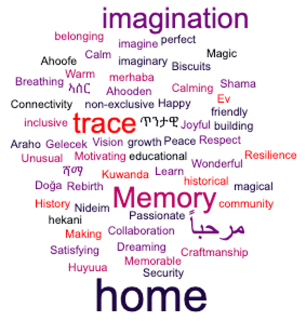A Story Growing from Traces
Published: 10 April 2024
Hyab Yohannes and Pinar Aksu about their connection with the Scottish Crannog Centre
By Hyab Yohannes and Pinar Aksu
We first visited the Scottish Crannog Centre (the Centre hereafter) two years ago, and since then, our connection to it has never diminished. It is important to note that both of us have migrant backgrounds. However, when in the Centre, our origins or backgrounds become irrelevant. We are simply humans deeply inspired by a profound sense of belonging that the Centre has left on us. In this brief blog, we would like to share our reflections on the opening of the Centre at a new location. We admit that we have yet to fully grasp the timeless story stretching back thousands of years. However, we feel completely moved by it, as if the story itself knows us.
On the opening day, we were amongst the many invited guests who celebrated the ceremony. We departed from Glasgow early in the morning, embarking on our journeys with friends and colleagues. On this unusually sunny morning, we were greeted by the whispering songs of birds, the graceful sway of trees, and the gentle passing of clouds as we made our way to the Centre. We sang along with the birds, with the help of smart devices and apps. We truly felt connected to the eco-social world of trees, birds, insects, humans, and the spirits who have been with us on this journey.
Upon arrival, we were moved by the transformation of the Centre from a state of ashes and ruins to a little village in a new location. We found that the Centre had relocated from one side of Loch Tay to the other. The Centre is well-known for its ‘museum’, which we will refer to as the ‘ancestral home’ in this blog. The ancestral home bears evidence of both past and present residents of the Crannog, telling a timeless story that echoes from beneath the Loch and beyond. On Easter Day, the Centre was reborn from its ruins, and soon its Crannogs will also rise from the ashes. The Centre proudly declared itself open, radically open.
During the day, we asked people to give us three words about their experience at the Centre. Obviously, we could not reflect on every word generously offered to us, so we chose three words that resonated with us: imaginative, home, and traces.

The Centre is a field of imagination; a place where the imagination knows no boundaries, limitations, or dimensions, yet it remains deeply connected with entangled relations of time, space, and history. Its interconnectedness radiates from a timeless and boundless world filled with emergent and emerging possibilities that we contemplate and share with profound attachment and grounding. Almost everyone we spoke to whispered this sense of profound attachment and grounding throughout the day. Yet, as many have admitted to us, we can only imagine the emerging story in its multiple intertwined imaginings and becomings.
Imagining a world entangled in history and memories of the past and present, the Centre reminded us of home. Everything we did, from breadmaking and wood carving to starting and gathering around the fire, allowed us to imaginatively connect with our respective homes that we grew in. The taste of the bread, the smell, the skill of flipping it from side to side, with many people gathering around to observe, and the act of sharing the food, transported us to the kitchens where our mothers and grandmothers fed us during our childhood. We were constantly reminded of imagining a future where our childhoods are not detached from our presence in a new place in the world.
In our imaginative reflection, we experienced a sense of connection with the ancestors of the Crannog village through their traces and spirits. As the Martinican poet and philosopher, Édouard Glissant, eloquently argues, the ‘trace’ serves as a guiding light that ‘puts us, all of us, wherever we are from, in Relation’. Glissant reminds us that ‘the trace was lived as one of the places of survival’. The Centre is filled with these small fragments of trace that recount the stories of eco-social humans that can be contemplated endlessly. The traces at the Centre are preserved in the 2500-year-old fingerprints of a child, as well as in artefacts, jewellery, tools, and everything else that surrounds the Centre. These traces invite us to decenter the human agency and engage in an imaginative contemplation with all things, every being, and even non-being. The rocks, wood, water, soil, and air bear witness to the embodied experiences we are reflecting upon. They appeal to our sensibilities, urging us to connect with them, their wisdom, and their spirits. The traces at the Centre, serving as our wandering guides in this imaginative inquiry, invite us to sing, dance, and contemplate alongside the inhabitants of the Crannog village – both living and non-living beings, as well as things.
The bottom line is that the opening ceremony filled us with warmth, joy, and a sense of community. It was a radical, yet hopeful, start to a promising future where we are all connected through a thread of traces. We are grateful to have participated in the Centre’s vision of non-exclusive openings and becomings.
About the authors
Both Hyab Yohannes and Pinar Aksu are researchers at the UNESCO RILA at the University of Glasgow.
First published: 10 April 2024
Visit the Scottish Crannog Centre

